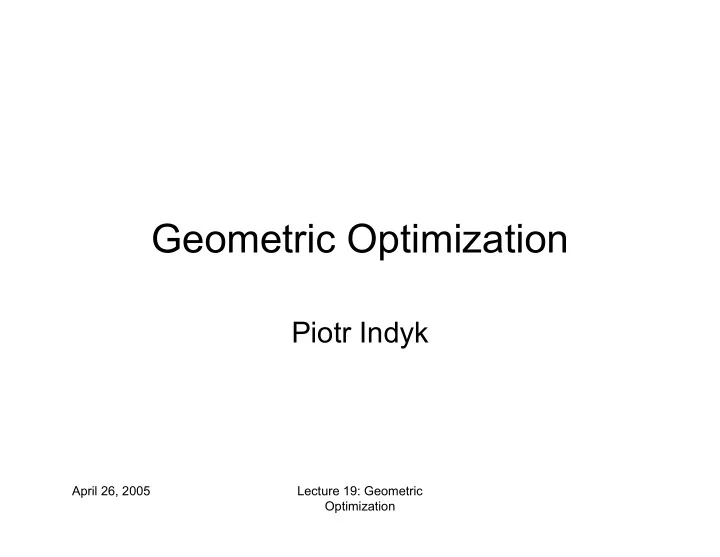

Geometric Optimization Piotr Indyk April 26, 2005 Lecture 19: Geometric Optimization
Geometric Optimization • Minimize/maximize something subject to some constraints • Have seen: – Linear Programming – Minimum Enclosing Ball – Diameter/NN (?) • All had easy polynomial time algorithms for d=2 April 26, 2005 Lecture 19: Geometric Optimization
Today • NP-hard problems in the plane – Packing and piercing [Hochbaum-Maass’85] – TSP, Steiner trees, and a whole lot more [Arora’96] (cf. [Mitchell’96]) • Best exact algorithms exponential in n • We will see (1+ ε )-approximation algorithms that run in poly time for any fixed ε >0 (so, e.g., n O(1/ ε ) is OK) • Such an algorithm is called a PTAS April 26, 2005 Lecture 19: Geometric Optimization
Packing • Given: a set C of unit disks c 1 …c n • Goal: find a subset C’ of C such that: – All disks in C’ are pair-wise disjoint – |C’| is maximized • How to get a solution of size ≥ (1- ε ) times optimum ? April 26, 2005 Lecture 19: Geometric Optimization
Algorithm k April 26, 2005 Lecture 19: Geometric Optimization
Algorithm, ctd. • Impose a grid of granularity k • For each grid cell a – Compute C(a) = the set of disks fully contained in a – Solve the problem for C(a) obtaining C’(a) • Report C’ =union of C’(a) for all cells a April 26, 2005 Lecture 19: Geometric Optimization
Computing c’(a) • The grid cell a has side length = k • Can pack at most k 2 disks into a • Solve via exhaustive enumeration → running time O(n k^2 ) • This also bounds the total running time April 26, 2005 Lecture 19: Geometric Optimization
Analysis • Approximation factor: – Consider the optimal collection of disks C – Shift the grid at random – The probability that a given c ∈ C not fully contained in some a is at most O(1)/k – The expected number of removed disks is O(|C|/k) – Setting k=O(1/ ε ) suffices • Altogether: running time n O(1/ ε ^2) April 26, 2005 Lecture 19: Geometric Optimization
Piercing • Given: a set C of unit disks c 1 …c n • Goal: find a set P of points such that: – P ∩ c i ≠ Ø for i=1…n – |P| is minimized • How to get a solution of size ≤ (1+ ε ) times optimum ? April 26, 2005 Lecture 19: Geometric Optimization
Algorithm k April 26, 2005 Lecture 19: Geometric Optimization
Algorithm, ctd. • Impose a grid G of granularity k • For each cell a – Compute C(a) = the set of disks in C intersecting a – Solve the problem for C(a) obtaining P(a) • Report P=union of P(a) for all cells a April 26, 2005 Lecture 19: Geometric Optimization
Computing P(a) • The grid cell a has side length = k • Can pierce C(a) using at most k 2 points • Sufficient to consider O(n 2 ) choices of piercing points (for all points in P) – Compute arrangement of disks in C(a) – Points in the same cell equivalent • Solve via exhaustive enumeration → running time O(n 2k^2 ) • This also bounds the total running time April 26, 2005 Lecture 19: Geometric Optimization
Analysis • Problem: disks B within distance 1 from the grid boundary • If we eliminated all the occurrences of the disks in B from all C(a)’s, one could pierce the remainder with cost at most OPT(C) • Suffices to show that the cost of piercing B is small April 26, 2005 Lecture 19: Geometric Optimization
More formally • Define B(a)=C(a) ∩ B • The cost of our algorithm is at most ∑ a OPT(C(a)) ≤ ∑ a OPT(C(a)-B) + ∑ a OPT(B(a)) = OPT(C-B) + ∑ a OPT(B(a)) • Also, ∑ a OPT(B(a)) ≤ 4 OPT(B) , since – Take the optimal piercing T of B – Define T(a)= T ∩ B(a) – We have OPT(B(a)) ≤ |T(a)| – Also, each element of T appears in ≤ 4 sets T(a) – Thus ∑ a OPT(B(a)) ≤ ∑ a |T(a)| ≤ 4 |T| = 4 OPT(B) April 26, 2005 Lecture 19: Geometric Optimization
Analysis ctd. • Suffices to show that the cost OPT(B) of optimally piercing B is O( ε OPT(C) ) • Let P be the optimum piercing of C • Shift the grid at random • All disks in B are pierced by P’=P ∩ ( G ⊕ Ball(0,2) ) • The probability that a fixed p ∈ P belongs to P’ is O(1)/k • The expected |P’| of is O(|P|)/k – Setting k=O(1/ ε ) suffices • Altogether: running time n O(1/ ε ^2) April 26, 2005 Lecture 19: Geometric Optimization
Dynamic programming for TSP • Divide the points using randomly shifted line • Enumerate “all” possible configurations C of crossing points • For each C, solve the two recursive problems • Choose the C that minimizes the cost April 26, 2005 Lecture 19: Geometric Optimization
Analysis • Structure lemma: for any tour T, there is another tour T’ with cost not much larger than the cost of T, which has only constant number of crossing points. April 26, 2005 Lecture 19: Geometric Optimization
Recommend
More recommend